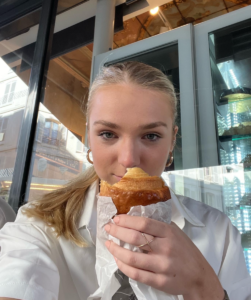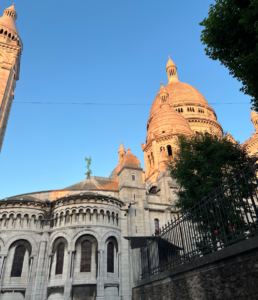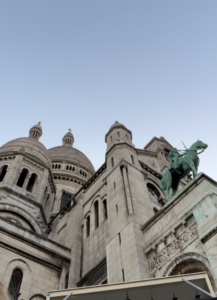The Sacré-Cœur has always been one of my favorite places in Paris. The views from the steps, the immaculate architecture, and the walk through Montmartre to reach the church are breathtaking every time. So, after walking through the streets below the church and

browsing various fromageries, bakeries, and other food shops, I put my picnic supplies in a backpack and walked up the seemingly endless stairs to the basilica.
Once I finally reached the top of the steps, I was greeted with the most incredible view out over the city. Sitting on the steps of the basilica eating my assortment of Parisian snacks and drinking my new favorite wine (a French Chablis), I was truly amazed by the size and beauty of Paris.
Though I didn’t venture into the basilica on this visit, I’ve been in before. Walking around the grounds and looking at the intricate gargoyles and arching doorways, I was once again impressed with the architecture and attention to detail that had so clearly gone into the building.
After my visit, I began to be curious about the relationship between experiences like mine and neuroscience. As someone who would characterize themselves as loosely religious, I wondered about the neural basis of religion and religious belief. After all, religion and

spirituality, regardless of form, is something observed all over the world in the grand majority of cultures.
After some searching on PubMed, I found a collection of articles discussing the neural correlates of religion and spirituality (R/S). The article I felt most drawn to was a review article of many of these prior studies which discussed not only prior work and findings but also the implications of these findings. Specifically, the article concluded that the medial frontal cortex, orbitofrontal cortex, and several other regions were particularly implicated in R/S beliefs and practice. The authors then postulated that these brain regions could lead to further effects on “mood, anxiety, psychotic, pain, and vertiginous disorders” (Rim et al, 2019). These findings, which were consistent across a variety of religions including Christianity and Buddhism, pose essential considerations for future research in this field. As religion is such a hot-button topic in our world today, understanding the way that it is based in peoples’ brains is vital and fascinating.
I honestly couldn’t tell you to what extent my frontal lobe was activated during my visit to

the Sacré-Cœur, I can tell you that the experience was breathtaking. I definitely think that the ability to experience and read about something that felt so much larger than myself was fascinating, and it is something I’ll continue to consider going forward.
References:
Rim, J. I., Ojeda, J. C., Svob, C., Kayser, J., Drews, E., Kim, Y., Tenke, C. E., Skipper, J., & Weissman, M. M. (2019). Current Understanding of Religion, Spirituality, and Their Neurobiological Correlates. Harvard review of psychiatry, 27(5), 303–316. https://doi.org/10.1097/HRP.0000000000000232
